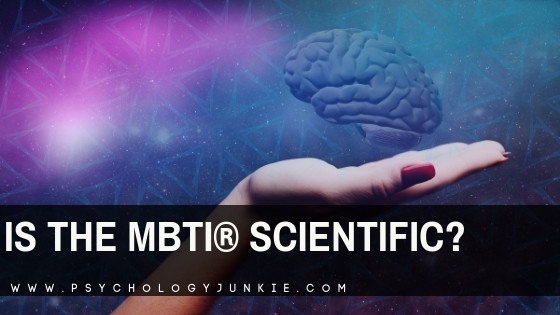Is the MBTI® Scientific?
The Myers-Briggs Type Indicator® is an assessment that aims to sort people into one of 16 different personality types. The indicator is derived from the work of Swiss psychoanalyst C.G. Jung, who first wrote about psychological type in his groundbreaking 1921 work, Psychological Types. The MBTI® assessment is used by 80 percent of the Fortune 500 companies and 89 of the Fortune 100 companies. It is loved and hated by psychiatrists, adored and despised by internet users everywhere.
But no matter how popular the indicator is, how accurate or scientific is it really?

“Is this just another Buzzfeed-style test?”
“How do I know this is actually accurate?”
“Is this like….”What kind of Disney princess are you?””
In our social media culture we are inundated with new ways to pad our egos. It feels great to take a test and learn that you’re just like Daenerys Targaryen or you’re as dangerous as Loki! But where does the MBTI® stand in relationship to the rest of the personality tests on the market? That’s what we’re going to take a look at in this article!
Not sure what your personality type is? Take our new personality questionnaire!
Is the MBTI® Scientific?
According to Award-winning UCLA Professor Dario Nardi, there is scientific proof that the eight cognitive functions described by Carl Jung (and referenced in Myers-Briggs theory) actually correlate with brain activity. Nardi has spent years conducting EEG scans on people of different ages and genders to test whether or not psychological type actually shows up in the brain. Through his brain scans, he was able to find provable links between type theory and brain function. After conducting MBTI® assessments, he would hook individuals up to an EEG monitor and expose them to various activities, questions, and stimuli to observe how they used their brain in response. He was able to see how each of the 16 Myers-Briggs personality types consistently used very particular brain regions to solve problems or interact in the same experiments.
For example, Ne types (ENTPs, ENFPs, INTPs, and INFPs), when hooked up to an EEG monitor, exhibit more frequent trans-contextual thinking than the average person. This type of brain pattern shows up when people rapidly process stimulus across multiple brain regions, including regions that seem inapplicable at first. It’s what we use when we find relationships across situations, brainstorm, or find creative comparisons. This correlates with how Myers-Briggs and Carl Jung described Extraverted Intuition, the mental process favored by NPs.
Si types (ISTJs, ISFJs, ESTJs, and ESFJs), exhibit a mental flow state when recalling past experiences in detail. This “flow state” shows up on an EEG monitor when all neocortex regions are synchronized and at maximum amplitude. This correlates with the Myers-Briggs definition of Introverted Sensation as a function that focuses on comparing and contrasting past details to present experience.
Ni types (INFJs, INTJs, ENFJs, ENTJs) enter a flow state when envisioning the future or solving a complex, new problem.
Te types (ESTJs, ENTJs, ISTJs, INTJs) rely on left-brain regions to quickly work up sufficient, evidence-based decisions.
Se types (ESTPs, ESTPs, ISFPs, ISTPs) show a “tennis-hop” brain pattern. This occurs when all regions of the neocortex are low amplitude and out of synch. It enables SP personality types to take tactical action, be attentive, and respond to surprise, incoming tasks.
Fe types (ESFJs, ENFJs, ISFJs, INFJs) show brain activity that reflects their focus on social responsibility and feedback. They use neocortex regions that help them communicate, evaluate other people’s behavior, and analyze for the future.
Fi types (ISFPs, INFPs, ESFPs, ENFPs) show high activity in brain region F8. This is where we rank information in order of importance or worth. It’s what we use when we say things like, “my values” or “my music”.
Ti types (INTPs, ISTPs, ENTPs, ESTPs) can holistically weigh numerous pros and cons of many uncertain or risky factors or options to come to a logical decision. This is largely because they rely so heavily on parietal brain region P4.
To sum it up, Dario Nardi found that the 16 different Myers-Briggs personality types used their brain in patterns that were unique to their type and coincided with the descriptions of Jung’s cognitive functions.
This is just a tiny glimpse of what Dario Nardi found when he did his research on personality type and the brain. You can find out much more in his book, Neuroscience of Personality: Brain Savvy Insights for All Types of People here.
You can also find more scientific research in the following links:
How You Use Your Brain – Based on Your Myers-Briggs® Personality Type
Here’s the Science Behind Your Myers-Briggs® Personality Type
Can the MBTI® Be Proven? What Reliability or Validity Testing Has Been Done?
Science isn’t just about brain scans, though. The MBTI® questionnaire itself is only useful if it can be shown to be reliable time and time again. If someone gets an ESTP result on the questionnaire one day, an INFJ result the next, and an ISTJ result four weeks later then how reliable is it?
The MBTI® Forms have been modified and perfected many times to ensure that it’s as accurate as possible. The indicator was created in 1942 and modified in 1977, 1987, and 1998. The questionnaire is meant to be given as part of a consultation process and not as a stand-alone “test”. This is what separates the MBTI® from many of its knock-off competitors like 16 personalities or other online tests.
In a typical Myers-Briggs consultation a client will:
- Fill out the Myers-Briggs Type Indicator and then hand it to a practitioner who will score it for them. (They may also fill it out online).
- The practitioner will then look over the results to see how clear the preferences are (for example, if a client is on the mid-point for T/F then further clarification might be needed).
- The practitioner will sit down with the client and explain the preferences in clear, easy-to-understand language. They will ask the client which preferences they relate to the most, clarifying that we all use both preferences at different times.
- Once the client has a thorough understanding of the preferences (I/E, S/N,/T/F, J/P) and has verbally indicated which they prefer, the practitioner will then ask them to read a type description for their most likely type.
- The client will read the description and let the practitioner know if this seems like the best fit. He or she might circle anything that doesn’t seem to fit.
- If there is any further confusion, the practitioner will help the client with that, perhaps bringing up another type as a possibility or accounting for other reasons (life experience, traits, quirks) that the individual might not relate to the type given.
- It is only once the client has a thorough understanding of the type preferences that they will pick their “best-fit” type. Nobody chooses their type for them.
This one-on-one consultation eliminates the likelihood that someone will mistype or get an inaccurate result on a test. Practitioners are trained to help clients sort out their most likely type and avoid typing themselves based on “masks” they might wear as a parent, friend, or employee. The indicator without the consultation is not nearly as effective.
Reliability and Gender
The MBTI® has also been modified so that no gender differences get in the way of its accuracy. For example, the first version of the MBTI® tended to score many women as feeling types simply because when it was created (in 1942) many women were expected to exhibit feeling-typical tendencies. The questionnaire has since been modified so that even a woman pressured by society to fit a certain role can still get a “T” result if she is a thinking type.
Test-Retest Scores and Reliability
What happens if you test one week as an ESTJ and the next week as an ISFP? While this is likely to happen in knock-off versions of the test, it’s much less likely to happen when the official MBTI® is administered. That’s because taking the actual assessment with a consultation gives the individual the chance to ask questions, clarify their true personality outside of work or home life, and helps them to get a result that isn’t based on an ever-changing “mood”.
In several case studies taken over the course of several months to a year, it was found that on average 75-90% of the people who take the MBTI® will retest and get the same result. This is actually quite high for a personality questionnaire and is roughly similar to the test-retest reliability of the Big 5 psychometric test.
Overall, the internal consistency of the four MBTI scales is exceptionally high in all samples available to date. You can find much more information about the reliability and validity studies conducted in the MBTI® Manual – Third Edition.
Myers-Briggs Validity Studies
Literally thousands of research studies have been conducted with the MBTI assessment. You can find these studies in the Isabel Briggs Myers Memorial Library. Some of these studies include:
- Studies of preference interactions
- Studies of type dynamics and whether particular groups of types differ in observable ways
- Analysis of variance (ANOVA).
- Brain scans of extraverted and introverted students to show observable differences
- Studies on type and creativity
- Correlations between the MBTI® and Strong Interest Inventory® Tool
- Correlation of MBTI® and the NEO-PI™
- Correlation of MBTI® and FIRO-B® Instrument
- Correlation of MBTI® and the California Psychological Inventory Instrument, Form 434
The point is, rigorous research has been conducted to support the MBTI model. Correlations of the four dichotomies (I/E, S/N, T/F, J/P) with a wide variety of scales of other instruments support the predictions of type theory.
Is This Scientific Enough?
I don’t know if a research study will ever be able to completely prove the scientific reliability of any personality questionnaire. But the MBTI® ranks very highly as one of the most thoroughly tested and scientifically researched typology theories to-date. I’ll be keeping my eyes open for any more research that comes out in the future and will keep you all posted here on my blog! You should also check out Dario Nardi’s Google Talk about type theory and the brain!
Sources:
Neuroscience of Personality: Brain Savvy Insights for All Types of People
MBTI® Manual – A Guide to the Development and Use of the Myers-Briggs Type Indicator® Instrument
Dario Nardi: “Neuroscience of Personality” Talk with Google
Subscribe to Our Newsletter

Want to discover more about personality type? Get the inside scoop with Susan Storm on all things typological, along with special subscriber freebies, and discounts on new eBooks and courses! Join our newsletter today!












Since I found CS Joseph’s lectures, I’ve really learned why MBTI is so unreliable and superficial.
John Beebe & Linda Berens additions to Jungian Psychology are missing from MBTI, which has shown it to be unreliable and superficial due to the lack of Temperament & Interaction Styles and cognitive attitudes.
3rd Function is stronger than 2nd function, especially earlier in life so a T in third position (and therefore F in second) will be registered by MBTI as being higher than the F and class them as a T type, when they’re an F. Just as someone with a developed 4th function can significantly outweigh 2nd (sometimes even 3rd or even dominant function at certain times) function because it’s a constant fear that can dominate ones decisions.
I’ve come across a few INFPs online now who believe they’re INTPs because they’re pretty hardcore academics who greatly value thinking and because they’re so academically smart, they appear to many to be a “thinking” type due to the false stigma attached to INFPs.
I’ve really appreciate a good number of articles on this site, but I really wish you’d update your understanding of Jungian beyond the now archaic MBTI.
I’ll certainly be getting hold of Dario’s book however, I’d heard of the research/findings before and need to dig into his methodology as I have an idea about how different “sides of the mind” might occur in the mind/nervous system.
Hi! CS Joseph does have some very interesting videos. I’ve spent a great deal of time studying John Beebe’s 8-function model as well as the temperament and interaction styles from Linda Berens work. While I like the 8-function model, and I may write about it more (I’ve done three articles about it at this point), I don’t know that I can fully align with it just because I haven’t seen enough empirical evidence to support it. I’m open to being persuaded though! Linda Berens work is really good and I love her books and would love to take one of her courses one day. Thanks for the input!!
I am Enfj
Hundred times did test get the same